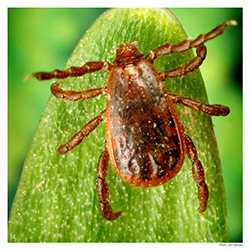NCEZID: Vector-borne Diseases (caused by bites from mosquitoes, ticks, or fleas)
Everyone—in the United States and around the world—is vulnerable to diseases spread by infected insects or ticks, also called vectors. Increasing global travel and urbanization are contributing to vector-borne disease outbreaks in new regions and countries. These diseases can be difficult to prevent and control, particularly since vaccines are available for only a few of them. NCEZID’s work, directed by national and international leaders in vector-borne pathogens, is focused on priority diseases, including:
- Zika (causes severe birth defects), chikungunya (causes debilitating joint pain), and dengue (can be deadly), which are caused by bites of infected Aedes aegypti and Aedes albopictus mosquitoes. Forty percent (40%) of the world’ s population is at risk for dengue infection.
- West Nile virus is now native to the United States, and outbreaks are reported each summer. The deadliest West Nile virus outbreak in the United States occurred in 2012. Although most people infected with West Nile virus will have no symptoms, about 1 in 5 will experience fever with other symptoms, and less than 1% will develop a serious, sometimes fatal disease.
- Lyme disease is the most commonly reported vector-borne illness in the United States, with an estimated 300,000 infections occuring each year. Other tickborne diseases like Rocky Mountain spotted fever are also a serious public health problem and can be deadly within days if not treated promptly with antibiotics.
What we’re doing:
- NCEZID has worked with partners on recent vector-borne outbreaks including Zika and chikungunya in Latin America, dengue in Hawaii, plague in Yosemite National Park, and Rocky Mountain spotted fever in Arizona and New Mexico.
- Early in the Zika outbreak, NCEZID scientists developed a new test called the Trioplex that detects Zika virus, dengue, and chikungunya in a single test.
- CDC is partnering with the Minnesota Department of Health and the Mayo Clinic to obtain up to 30,000 clinical specimens from patients with suspected tickborne illness over a 3-year period. CDC will use genetic sequencing methods to identify the specific tickborne bacterium that caused these patients’ illnesses.
- NCEZID scientists have found nootkatone, an ingredient found in Alaska yellow cedar trees, some herbs, and citrus fruits, to be an effective repellent and insecticide for use against mosquitoes, ticks, and other pests. Efforts are now underway to bring this product to market.
Since 2004 in the US, scientists have discovered 7 new tickborne viruses in people.
- Page last reviewed: August 28, 2017
- Page last updated: August 28, 2017
- Content source:
Centers for Disease Control and Prevention
National Center for Emerging and Zoonotic Infectious Diseases (NCEZID)


 ShareCompartir
ShareCompartir
